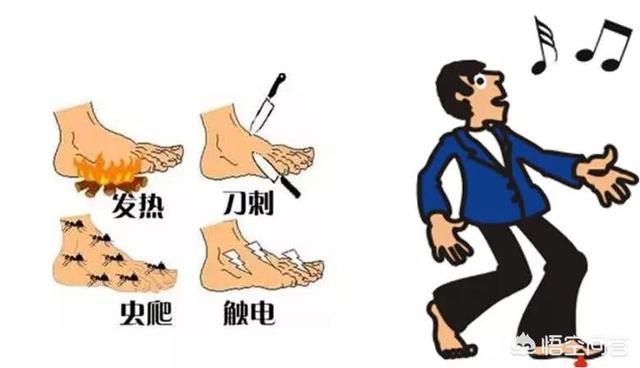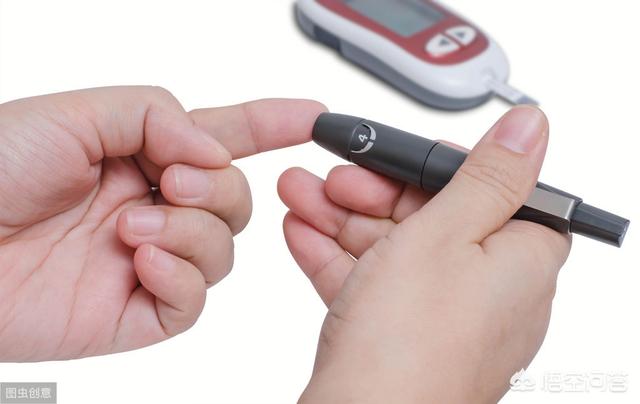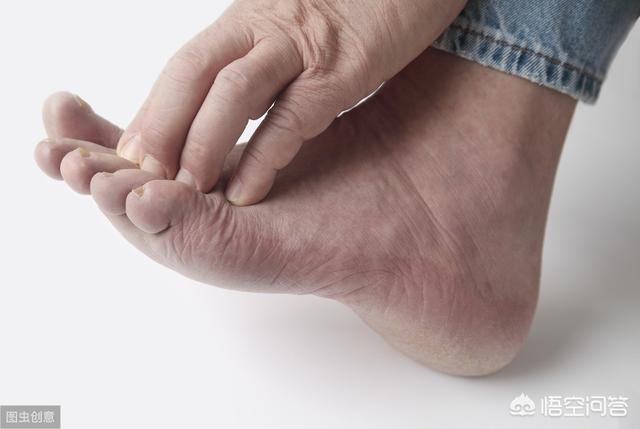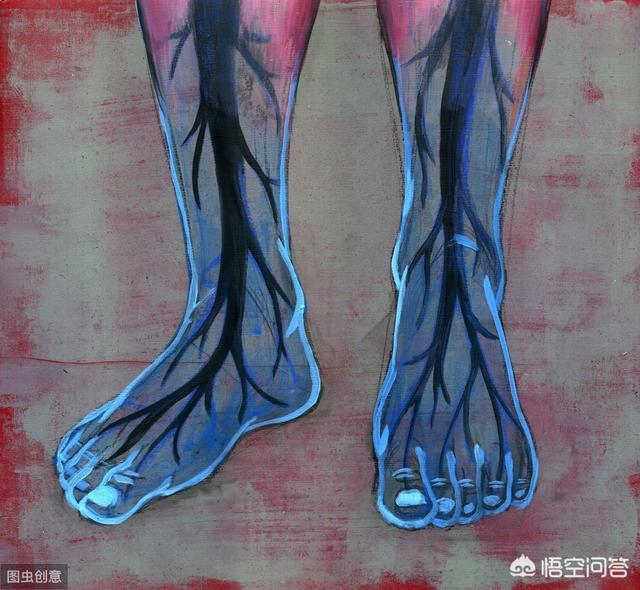Blood sugar isn't high, but why is there neuropathy?
Diabetic neuropathy is one of the most common complications of diabetes mellitus, but the onset of the disease is more insidious, not easy to be detected, most of the patients are through the clinical examination or the emergence of the corresponding symptoms were found, early may not be symptomatic, some diabetic patients in the early stage of diabetes mellitus may be manifested as foot pain, with a clear diabetic neuropathy may manifest as foot pain, sensory abnormalities or Patients with definite diabetic neuropathy may present with foot pain, abnormal sensation or no sensation at all, but this is rarely reported, and mild to moderately severe sensory deficits may be detected on physical examination.
However, the pathogenesis of diabetic neuropathy is not well understood, and some studies have suggested that the factors of diabetic neuropathy are related to the following categories of causes:
I. Hyperglycemia is the most important factor in diabetic neuropathy
II. Elevated blood pressure
III. Lowering of high-density lipoprotein and cholesterol
IV. With microalbuminuria
V. Centripetal obesity
VI. Course of diabetes
VII. Drinking and smoking
In conclusion, various metabolic changes and vascular factors are involved in so stages of diabetic peripheral neuropathy, in which impaired blood flow and nerve endothelial hypoxia play an important role in diabetic peripheral neuropathy, it does not mean that you will not get diabetic peripheral neuropathy if you have good glycemic control, so we must do a good job of regular monitoring and prevention about peripheral neuropathy.
Prevention has the potential to reduce the risk of nerve damage:
1. Keep your blood sugar as close to normal as possible
2,nonsmoking
3. Lose weight (if overweight)
4,Make sure you are treated for high blood pressure and heart conditions (if you have them)

In the clinic, I often hear some diabetic friends are indignant, my blood sugar is not high, why do I have complications? The question is similar to that of the subject! Yes, how can I have complications if my blood sugar is not high?
There are actually many problems with this statement from a clinical treatment perspective. Let's analyze it in detail:
We cannot determine whether our diabetic friend's blood glucose control is ideal or not from a single figure alone. The gold standard of blood glucose control is glycosylated hemoglobin, which reflects long-term blood glucose control. Of course, if the patient is more careful and able to perform regular blood glucose profile checks can also indicate the usual blood glucose control.
According to the recommendations of the Chinese Diabetes Prevention and Control Guidelines, glycated hemoglobin should be kept below 7%, so that the chance of complications will be relatively low.
The subject's blood glucose is 6.3 mmol/L, does this mean that his blood glucose is very well controlled?
This is not always the case; the blood glucose value is an instantaneous blood glucose that simply indicates the patient's blood glucose at a certain point, which may be the patient's fasting blood glucose, and his postprandial blood glucose may remain above 20 for a long period of time; or it may be a result of a random test during the correction of the patient's hypoglycemia, and the subsequent mechanism of the body's regulation, which will cause his blood glucose to rise rapidly to above 20.
Studies have shown that poor long-term control of blood glucose and large fluctuations in blood glucose can lead to complications. Therefore, it is very important to keep your blood sugar stable.
There is another situation that is also more common in the clinic, where the patient has developed neuropathy because of poor blood sugar control. Later, after careful control of blood glucose, the blood glucose can be kept relatively stable, but unfortunately, the discomfort in the lower limbs still exists. This is because the chronic complications of diabetes are almost irreversible.
It is very important for the subject to check blood sugar and glycosylated hemoglobin eggs at different times so that even if neuropathy develops, its progression can be slowed down and serious consequences can be prevented.
It is also important to note that diabetic neuropathy is an exclusive diagnosis, which means that spinal lesions, alcoholic nerve damage, pharmacologic nerve damage, nerve damage due to Guillain-Barre, etc., must be ruled out before a diagnosis of diabetic neuropathy can be made. Therefore, if your blood glucose remains stable for a long period of time, you have to rule out the above factors as well.
I'm Dr. Sun, pay attention to Dr. Sun talk about sugar, continue to learn more quality health knowledge, help please like, have questions please leave a message, will reply!
Diabetic neuropathy is one of the more common complications in patients with diabetes, and can occur in the central and peripheral nerves, affecting the trunk, extremities, head and face. Diabetic peripheral neuropathy (DPN) is more common and refers to symptoms associated with peripheral nerve dysfunction in diabetic patients when other causes are ruled out.
There are many causes of neuropathy, and in addition to oxidative stress due to dysglycemia, vascular ischemia and hypoxia, and nerve growth factor deficiencies, autoimmune factors, vitamin deficiencies, genetics, and environmental factors have also been implicated in the development of the disease.Therefore, blood sugar disorders are not the only trigger for neuropathy, so it is possible for people who do not have high blood sugar to develop neuropathy. There are many symptoms of neuropathy, but the three main categories are coldness, numbness and pain. Patients with neuropathy may have 1 or 2 symptoms or all three.
Nerves in diabetic patients are more prone to injury, which is caused by long-term poor control of blood glucose, resulting in lesions of large blood vessels or microvessels. Vascular lesions cause poor blood circulation, so that the nerves do not get enough nutrients, and of course, they are more prone to problems.Cold fingers and toes, which are more common in diabetics, are peripheral neuropathy caused by poor circulation.
If pain is present, it is mostly caused by nerve hypersensitivity. When the patient develops numbness in the hands and feet, for example, like wearing gloves or socks, it means that the nerve reaction has been slowed down and the nerve damage is more serious. Details about the dangers of neuropathy and ways to prevent and control it are as follows:
The dangers of neuropathy
Neuropathy manifests and affects itself differently depending on the location of the neuropathy.When a patient has abnormal skin sensation, he or she lacks the normal perception of temperature and pain, which can cause many unintentional injuries.For example, when soaking the feet, as they cannot sense the water temperature, they may be burned due to the high temperature; if they are stabbed by foreign objects such as nails when walking, as they cannot feel it in time, they may have already developed an infection by the time they realize it. Of course, some patients may also experience sensory hypersensitivity, and may not be able to sleep due to pain all over their body, seriously affecting their normal life.
Neuropathy can be even more dangerous when accompanied by cardiovascular system disease. For example.Some sugar patients may have painless heart attack, this is because after severe lesions of autonomic nerves, it will make the patient will not have the feeling of suffocation, discomfort and severe pain as normal people do when the myocardial ischemia or infarction occurs, so that they can not be detected in time, which will often lead to more serious consequences.Neuropathy can involve the digestive system, causing gastroparesis, which weakens peristalsis and delays food emptying, and may also be accompanied by nausea, vomiting and bloating.
Prevention of diabetic neuropathy
Diabetic neuropathy is an early complication, occurring within three to five years of the disease, which causes lesions in the nerve endings. Macrovascular lesions appear even earlier, in about 30% to 50% of diabetic patients at the time of diagnosis.In general, diabetics with better glycemic control are less likely to develop neuropathy. For patients who have already developed neuropathy, the condition can be improved through relevant measures.
The first step is to strengthen the monitoring of blood glucose, not only to control it at a lower level, but also to keep it stable and reduce the fluctuation of blood glucose. Then it is to improve blood circulation, such as applying drugs to reduce blood viscosity or antiplatelet drugs to improve the circulatory condition of large blood vessels and microvessels, and also use vasodilating drugs if needed. Finally, it is to strengthen the nerve nutrition, such as the application of some nutritive nerve drugs. For patients who have smoking habit, must firmly quit smoking.
Examination of diabetic neuropathy
After a diagnosis of diabetes, screening for peripheral neuropathy should be performed annually, and in patients with a long course of the disease and other comorbidities, screening should be performed at 3 to 6 months. This generally includes ankle reflexes, vibration sensation, pressure sensation, pinprick pain sensation, and temperature sensation.
In general, both sides should be examined because, with the exception of the ankle reflexes, which need to be diminished or absent bilaterally at the same time in order to be judged positive, the other four are diagnosed as positive if they are unilaterally abnormal or absent.The examination environment should be quiet, comfortable, and at a suitable temperature (around 25°C), and care should be taken to avoid areas with ulcers, scars, calluses, and necrotic tissue.
Diabetic peripheral neuropathy
When it comes to diabetes, many people know "three more and one less", that is, polyuria, polydipsia, polyphagia and wasting, but not many people know that diabetes causes nerve pain. According to relevant data.Diabetic peripheral neuropathy has a high prevalence in diabetic patients and is significantly associated with the duration of diabetes mellitusThe prevalence of diabetes is less than 10% for patients who have had the disease for less than a year, more than 50% for those who have had the disease for more than 10 years, and up to 90% for those who have had the disease for more than 20 years.
It should be noted that 80% of patients with diabetic peripheral neuropathy will experience neuralgia. Diabetic neuralgia will affect the patient's sleep quality and mood, regular pain is even more difficult to sleep, the decline in sleep quality will seriously affect the patient's life, so that long-term sleepiness, fatigue, and then triggered by mental trance, and in serious cases, there will be anxiety, irritability, as well as depression and other mental disorders.
Peripheral neuropathy causes nerve pain because glucose metabolism impairs peripheral nerve nutrition.Prolonged high blood glucose will cause the blood vessels of diabetic patients to narrow and harden, and cause insufficient nerve nutrition and metabolic disorders, thus triggering neurodegeneration, which causes sensation to diminish or even disappear.In addition to this, increased aldose reductase activity, abnormal polyol metabolism, intracellular sorbitol and fructose buildup, cell swelling, and inositol depletion all contribute to impaired nerve function. All of these factors promote the onset and progression of peripheral neuropathy.
Diabetic neuralgia
The onset of diabetic neuralgia is relatively insidious, and the early symptoms are mainly some slight paralysis of the hands and feet, which often does not cause the patient's attention. But then, the patient's palms, feet will appear burning pain and needle-like pain, or numbness, worm crawling and fever and other sensations, usually more common in the lower limbs, the more serious will also appear lower limb arthropathy and ulcers.
How Chinese medicine looks at diabetic peripheral neuropathy
According to Chinese medicine, diabetic peripheral neuropathy belongs to the category of "impotence" and "paralysis", and prolonged treatment of thirst disease will deplete fluid, fluid injury and gas consumption, gas deficiency can not marshal the blood, and the blood line is not smooth, which will lead to stagnation of the blood network.When qi and blood cannot run to the ends of the limbs, the loss of nourishment of the tendons and veins will lead to this disease. In other words, the pathogenesis of the disease is deficiency of qi, blood, yin and yang, which leads to stasis, and blood stasis induces and accelerates the development of the disease.
For patients with diabetic peripheral neuropathy, the main focus should be on benefiting qi and nourishing yin, activating blood circulation and removing blood stasis.Astragalus and Radix et Rhizoma Ginseng can benefit Qi and nourish Yin to treat the root cause and remove dry heat to treat the symptoms. Radix et Rhizoma Ginseng, Radix et Rhizoma Puerariae, Rhizoma Coptidis, Rhizoma Atractylodis Macrocephalae, and Leeches can nourish qi, generate body fluid, and activate blood circulation. Yam, Salvia miltiorrhiza and gynostemma have the effects of strengthening the spleen and tonifying the lungs, consolidating the kidneys and benefiting the vital essence, activating blood circulation and eliminating blood stasis, and regulating lipids and lowering sugar.
Dongkai fruit can diuretic and facilitate water flow, which can help Cangzhu get rid of dampness. Patients can choose the capsule containing astragalus, danshen, gibberellic acid and other ingredients of Tongxin and hypoglycemic capsule according to their own situation and follow the doctor's instructions, which has certain therapeutic effects on diabetic peripheral neuropathy.
One final note.Treatment of neuropathy is a long-term process and it is difficult to see immediate results because it takes time for the nerves to repair. Generally, most symptoms can be relieved after about six months of comprehensive treatment.
This question and answer are from the site users, does not represent the position of the site, such as infringement, please contact the administrator to delete.